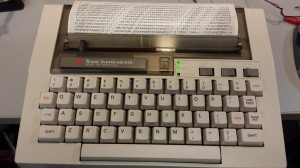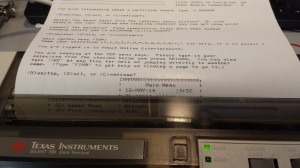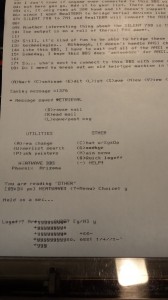In the early days of public online services, there were many ways to access information sources like Compuserve, BIX, and GEnie. You could use a desktop computer in the home or office… when you were in the home or office. Or, you could use a portable data terminal device like the Texas Instruments SILENT 700 series.
 The SILENT 700 comes in several varieties. This article will document details about the model 703 that I personally have in my collection. I just recently purchased the 703 at, of all places, an antique radio show. I got it cheap enough to take a risk that it may or may not work. If it didn’t work, and if it was beyond basic repair, I would have decided to hack it for parts. It came with a carrying case, the 703 itself, and the installed roll of FAX paper. There was no power supply.
The SILENT 700 comes in several varieties. This article will document details about the model 703 that I personally have in my collection. I just recently purchased the 703 at, of all places, an antique radio show. I got it cheap enough to take a risk that it may or may not work. If it didn’t work, and if it was beyond basic repair, I would have decided to hack it for parts. It came with a carrying case, the 703 itself, and the installed roll of FAX paper. There was no power supply.
The first thing I needed to do was figure out how to power the device. The product label states it uses 20 volts AC, a power source value which I had no direct solution for. The power connector had three pins. I assumed that the outer two pins were the AC source and the middle pin was Ground. Still, I had no 20 VAC power supplies. However, I have always been able to, IN A PINCH, substitute a DC power supply in most similar cases.
The theory of an AC power supply powered device is that the external part of the power supply is only a transformer which reduces the wall socket voltage to a more manageable level. Then, the circuitry inside the device acts as a full power supply, rectifying the AC to DC and powering the internal electronics.
Throwing caution to the wind, I used a 19 volt DC power supply I had lying around. chances are, there is a bridge rectifier immediately connected to the devices power supply connector. These are used to convert the constantly switching polarity of the AC coming in, to a form of DC that the device can use. So by using a DC voltage at the start, I’ll only be using part of the bridge rectifier. The remaining pert of the internal power supply won’t see anything much different than it would normally see.
 I am happy to report that my hunch worked. As soon as I turned on the SILENT 700, I got a prompt stating “703”, which is the specific version of the model I have. As soon as I typed something, The printhead started doing its line dance and printing what I typed. There is no ribbon in this device, nor is there an LCD or CRT display. All interaction is printed onto the heat sensitive thermal FAX paper. It’s the same kind of paper older FAX machines used. As the printhead moves along the line, it generates heat in a bitmap pattern, which produces the printed letters in turn. The nice thing about thermal printing is that it’s silent, hence “SILENT” 700.
I am happy to report that my hunch worked. As soon as I turned on the SILENT 700, I got a prompt stating “703”, which is the specific version of the model I have. As soon as I typed something, The printhead started doing its line dance and printing what I typed. There is no ribbon in this device, nor is there an LCD or CRT display. All interaction is printed onto the heat sensitive thermal FAX paper. It’s the same kind of paper older FAX machines used. As the printhead moves along the line, it generates heat in a bitmap pattern, which produces the printed letters in turn. The nice thing about thermal printing is that it’s silent, hence “SILENT” 700.
There were other models made in the SILENT 700 series. I believe they were the 707 and 709 series. Those versions had built-in phone line connectivity. One would connect to the phone with an acoustic coupler (soundproofed clip-on sockets which clip over the earpiece and mouthpiece of conventional phone handsets. My 703 model does not have a built-in modem. Instead, it had a 25-pin RS-232 compatible serial port, but with a female connector.
I could have hooked this up to an old external modem, but I already had a solution in place that allows me to bridge old RS-232 connections to modern day Telnet sessions on a Windows PC using a program called RealTERM. RealTERM lets me connect this to a serial-to-USB PC connection, then using RealTERM as an echo bridge to any telnet server I choose. RealTERM manages the connection on both ends and passes data back and forth between them. It even lets me use two different modem and parity settings. The SILENT 700 only supports: odd, even, mark, and space parity values. It does NOT support the more popular “NONE” parity. RealTERM took care of the differences for me.
 I logged onto a Telnet BBS I frequent on a regular basis, heatwavebbs.com. I was able to do most everything I could on the BBS as if I used a telnet program on a computer with a screen. The difference is, I use up paper as the SILENT 700 feeds the FAX paper through as text is being received. Plus, I was restricted to the 300 baud, so text wasn’t exactly racing up the printed page. What I ended up with is a paper trail of my online session, as seen on the right side.
I logged onto a Telnet BBS I frequent on a regular basis, heatwavebbs.com. I was able to do most everything I could on the BBS as if I used a telnet program on a computer with a screen. The difference is, I use up paper as the SILENT 700 feeds the FAX paper through as text is being received. Plus, I was restricted to the 300 baud, so text wasn’t exactly racing up the printed page. What I ended up with is a paper trail of my online session, as seen on the right side.
There’s really not much I can do with this outside of the novelty of it. Not many modern devices support the capabilities of the SILENT 700, even if it only works at 300 baud. I could connect it to an Apple, TRS-80, Commodore Amiga, IBM PC, or any hardware device that supports serial communications with ASCII text. The SILENT 700 does not support ANSI graphics (colorized text that requires special code sequences to display). ANSI looks like garbled text when it’s transmitting to an unsupporting connected device. If a wanted, I could hook it up to a serial port on a Linux box and use it for direct shell access to administer the Linux server.
Meanwhile, it gets added to my collection along with various other unique items. I could probably put it to use on a ham radio packet setup and have it display anything and everything that gets transmitted on a packet radio net.





Ahh, I see from the picture that you really did type that post about the Silent 700 with a Silent 700. Too cool!
Your idea about using it as the terminal to control a headless server (or I guess this would be the head) got me really excited! haha! It silently prints vintagevolts@computer:/$
wow! That would be so neat.
Hey, I picked up this same model at an estate sale not too long ago! Great post. I’m hoping to try out the uses mentioned (connecting to a telnet session, and ham radio packet). Being a licensed ham radio operator, I know I’ll be happy to use this as part of a packet setup.
If you need any help using RealTERM to connect it to an Internet based telnet BBS, let me know.
I have just obtained a model 703 and would like to connect it to my pc. You mentioned a serial to usb connection. Is that a null modem connection or standard?
Please advise.
Thanks.
There are USB adapters which provide a standard serial connector, usually 9-pin, on a PC. At that point, you will want to use a null modem cable to connect your 703 to the PC
Thank you Jeff.
I have two connected to my Linux box and can login no problem.
hey I came across a Texas Instrument silent 700 model 703 missing AC adapter and manual but I am a hundred percent it works what is your best offer if you are interested in buying
I found a 707 on Fleabay that appears complete. It has the carrying case, acoustic coupler, modem (built in), and the power supply. I’m going to be using it to connect to a simulation of an old HP Mainframe, the kind that used to be popular when logging in at a library or computer lab in the 70’s/80’s.
I’m using SimH to simulate the computer and running HP2100 running HP TSB (Time-Shared BASIC) So I can log in, write programs, etc. Should be a neat thing to play with.
That’s the nice thing about portable terminals like this, the convenience of a text terminal with hardcopy. What method are you going to use to connect the two systems together.
Well, I tried several different ways, since I don’t have the serial port version, it becomes very annoying to simulate a phone line, plus trying to find a USB modem that I can get working with linux. I ended up at the VCF hooking it up to someone else’s display where they were doing a BBS display. using the acoustic coupler I was able to “dial” into their BBS. But unfortunately, I wasn’t able to get it to talk to my HP2100 simulator. The 703 would have been the model that I needed. Well, time to figure out my display for the next VCF
You could set up a vintage emulator and OS like Hercules and connect to that.
I’ve come across similar challenges getting vintage equipment to connect to emulators running on more modern equipment. My most troubling scenario was interfacing a TI-99 to a Windows system to do file transfers. Establishing the physical connection can be an issue.
I believe the 707 version of the Silent 700 only has a telephone modem interface which may exclude direct serial connection. Although, any pictures I’ve seen of the 707 version are too dark to distinguish the actual interfaces, so it may just have one and I haven’t noticed it.
I would be very interested in seeing a dial-up interface being implemented between a 707 (or any vintage equipment) and a PC.
Hi, I have 703 that I am trying to get working over serial.
I have it connected to Realterm and am trying to send text between them, but I am not having any luck.
I wired up a null cable.
Is there a special key sequence to get the 703 connected?
Any suggestions?
Thanks,
Travis
Ok, I got this working.
I needed to correct my cable.
Neat stuff.
Yeah. The Silent 703 is rather versatile for its age. Anywhere you need a serial connection terminal interface, you can connect this up and get it to function as needed.
It’s not as portable as the TRS-80 Model 100 in that capacity, but at least you get the built-in hardcopy “scrollback buffer!” 🙂
Well, I have been able to get my Silent 700 to talk to my Model 100. If I can get a host program configured on the Model 100, I would actually be able to just connect the two acoustic couplers together and log in. 🙂
I have a Texas instrument acoustic coupler in the box part# 2310518-0001 if your interested
Hello, do you maybe know what switches the keyboar uses? thank you.
Hi guys,
I’m trying to connect my TI Silent 700 703 with my computer but I have no responses… I have tried with a raspberry, windows 10, windows xp, RealTERM, arduino serial… It’s no possible to me to see anything in my serial port.
Can you please explain to me how connect the silent 700 with a computer ? what is your specifications in RealTERM ? Have you just try to send ASCII with RS232 without telnet configuration ?
Let me know. Thanks for your text.
Best
Make sure you are using a null modem cable or adapter. A null modem connector switches the TX and RX signals between two devices, enabling two-way communications. If you are using any adapters to go between DB9 and DB25, make sure those are not null modem adapters if the cable is already wired as a null modem. Basically, between all of the cables and adapters you may be using, you must only have one of them be a null modem.
Thanks for your response Jeff! I make a null modem cable and it’s work fine!
So now I have an other problem, and I don’t know why…
I use a prolific usb db9 cable with my MacBook. The communication works well at 300 baud. The TI can read and write all ascii caracteres.
But when I try to connect the TI in a raspberry or an old windows, I have a problem with the communication. When I write on the computer, and read on the TI, this caracteres don’t want to be transfert : C E F I J L O Q R T W X 3 5 6 9
When I write in the TI and read in computer, I read only this caracteres…
Have you any idea about this pb? I never see that with a serial port :s
For information, the partial transfert is all time the same, and the same with windows xp or raspberry.
Best regards
Ok i found the pb. Stop bits is 7 in doc, and I tried with stop bits 8…
I never paid close attention to what would happen with an incorrect bit setting, but the symptoms you had make sense. When the proper amount of bits is not coming as expected, they get interpreted as something else.
Congratulations on getting it to work again. I apologize for not responding sooner. I don’t always get notifications of new messages on this board. Something with my email server configuration.
If anyone is interested, I have a TI 707 with Manual and case.